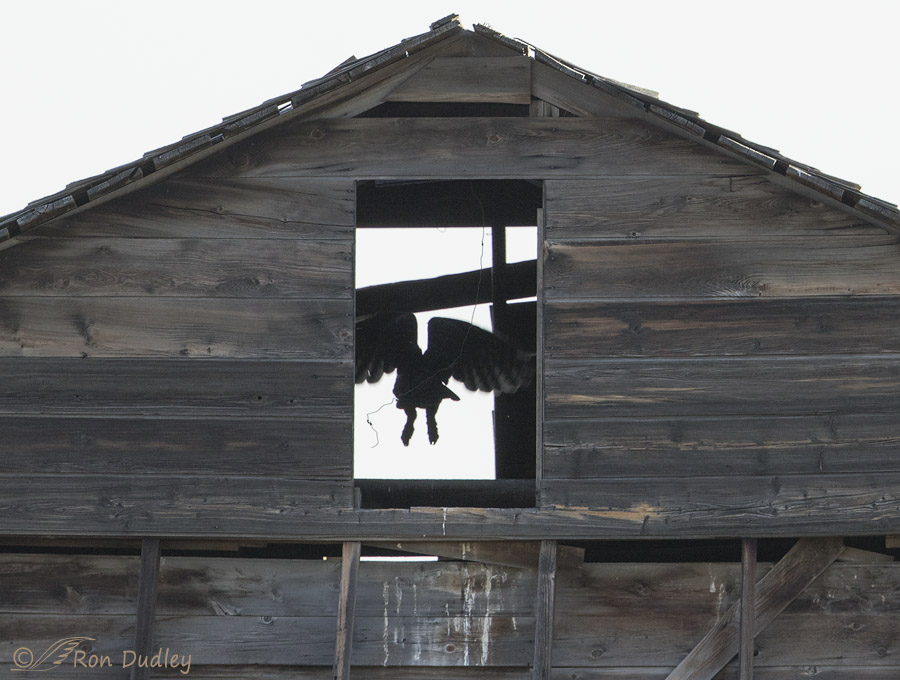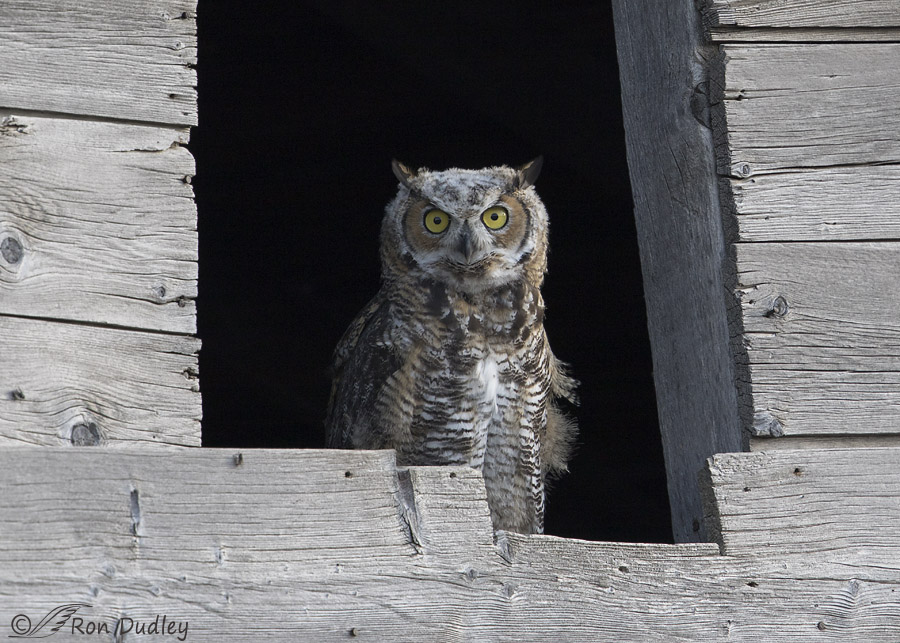The Great Horned Owls on the Montana farm are unusually shy this summer so I only had two brief encounters with them on my recent trip. They spend most of the day in the darkness of the old granaries and only come out to hunt at night. The granaries have cut-outs for grain augers both near the roof and at ground level so it would be easy to stick my head inside to check on them but I never get close for fear of disturbing the birds.
I did discover that there is one way of checking on them from a great distance. From just the right spot on a slightly elevated dirt road perhaps 300 yards from one of the granaries I can scope through the upper cutouts with my lens and sometimes see the birds perched on the interior rafters.

That’s what I was doing when I took this backlit shot. I just happened to fire as one of the owls lifted off from an interior rafter and flew through the far cutout on a rare daytime visit to another old granary. I don’t know what the stringy thing is hanging down but apparently it’s no problem or danger to the owls because they’ve been roosting and successfully nesting in this granary for about 20 years that I know of.
Apparently there are three owls present – a mated pair and a single juvenile from this year’s nesting season. One owl was found dead far away from this granary earlier this summer and I suspect it was another young bird.
 1/320, f/6.3, ISO 500, Canon 7D Mark II, Canon EF500mm f/4L IS II USM +1.4 tc, not baited, set up or called in
1/320, f/6.3, ISO 500, Canon 7D Mark II, Canon EF500mm f/4L IS II USM +1.4 tc, not baited, set up or called in
This is the juvenile, perched in the far cutout you see in the first image. Its ear tufts (horns) are only partially grown and it still has remnants of its juvenile plumage especially on the head (grayish-white color) where it is the last to be replaced.
Something interesting happened just before I took this image and I was able to record much of it with my camera but most of my images from the trip have yet to be downloaded and culled so I can’t include that incident this morning.
I hope to post “the rest of the story” in a day or two.
Ron
Note: I swear that these northern Montana owls are significantly larger than those I see 700 miles further south here in northern Utah. It’s something that (I think) I’ve noticed for years. Does anyone know if that’s possible or likely? Since the species is non-migratory and it fits the rule of thumb that vertebrates living in northern climates often have more massive bodies than those living further south it seems to me that it could be the case…


Love the shot with the Owl framed by the barn, and those big eyes. It was sure curious about you.
Thank you, Jean.
Learning again. This time as well as an increase in my avian knowledge I picked up some (less welcome) self knowledge. I am speciest. Adolescent birds melt my heart sooooo much quicker (and more completely) than any teenager I have ever met.
Juvies do tend to tug at the heart, don’t they, EC?
I really like that you caught this bird at that “still fuzzy” stage.:D
Thanks, Arwen.
A wonderful shot Ron! I hope they are more successful with their next brood. We have an “Owl Man” Mark Crankshaw in St. Louis that watches a mated pair in the large park (Forest Park) in St. Louis City. He visits faithfully every night, has both the owls named, gives tours, does lectures, radio shows etc. He even has videos on you tube, but he’s certainly not the photographer that you are. https://www.youtube.com/channel/UCQ_ul8vL_2VIU6bIcunJUNA However, I did learn from him that owlets cannot stay in their parents territory, they must go out and find their own which I thought was interesting.
Charlotte
“owlets cannot stay in their parents territory, they must go out and find their own”
From what I’ve observed of these owls over the years, he’s right, Charlotte. The young birds always disperse when they get old enough.
Nice shot Ron, can’t wait to see the rest!!
I used to band birds and take many measurements, e.g. weight, wing lengths, tarsus length, etc. There is a large group of banders that do the same thing as well as professionals that write up their data. The data supports the rule of thumb, so I don’t know why your information and observations would be any different.
Thanks for that feedback, Dick. Trying to judge size through a lens or in my photos is tricky at best but they sure do seem larger up there!